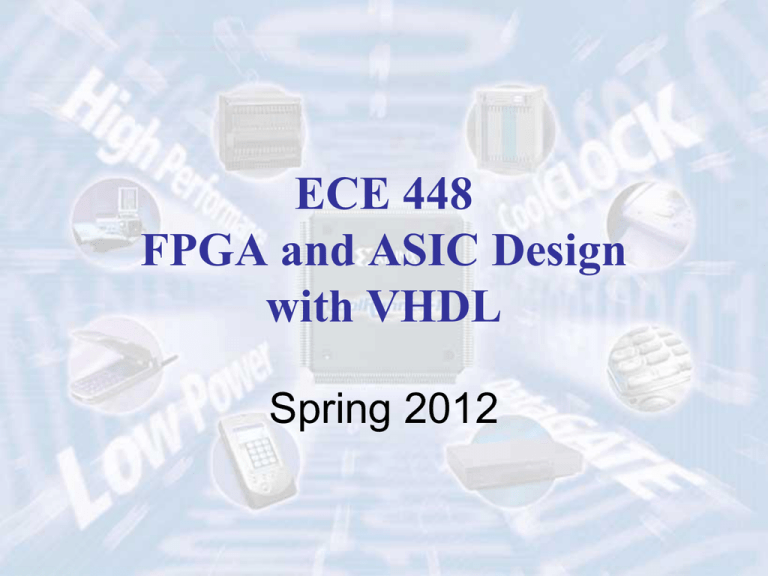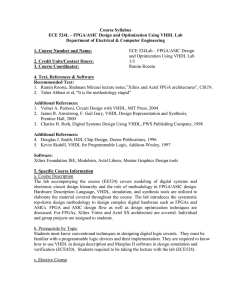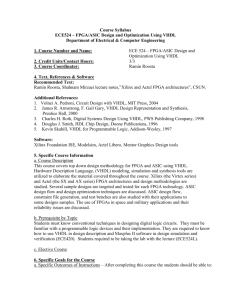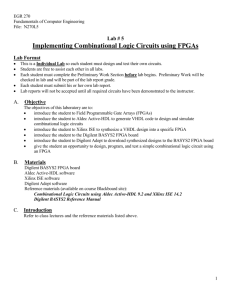Lecture 1 - the GMU ECE Department
advertisement

ECE 448
FPGA and ASIC Design
with VHDL
Spring 2012
ECE 448 Team
Course Instructor:
Kris Gaj
kgaj@gmu.edu
Lab Instructors (TAs):
Tuesday & Thursday section: Umar Sharif
malik.umar.sharif@gmail.com
Wednesday section:
Danesh Esteki
danesh.esteki@gmail.com
Homework & quiz grading:
Bilal Habib
bhabib@masonlive.gmu.edu
ECE 448 Team – Division of Tasks
Course Instructor – Primary Responsibilities
- Lectures
- Preparing quizzes and exams, grading exams
- Coordination of work on development
of new experiments
- Approving instructions for the lab assignments
- Coordination of work done by the TAs
- Enforcing consistent policies and grading standards
- Mid-semester student satisfaction survey
- Resolving conflicts and providing feedback to the TAs
- Holding office hours
ECE 448 Team – Division of Tasks
Lab Instructors (TAs) – Primary Responsibilities
- Teaching hands-on sessions on how to use software,
hardware and testing equipment needed in
lab assignments
- Introductions to lab assignments
- Grading student demonstrations and reports
- Holding office hours
- Development and testing of new lab assignments
ECE 448 Section Assignment Rules
• You should do your best to attend all lab meetings
of the section you are registered for
• If you have missed a meeting of your section
please attend a meetings of any other section but
give preference in access to the lab computers
to the students attending their own section
• All lab assignment demonstrations need to be done
in the presence of your TA, and can be normally
done exclusively during the class time of your section
• Any requests for exceptions to these rules
(due to illness, accident, etc.) should be well documented
and presented to the main instructor for approval.
Course Hours
Lecture:
Tuesday, Thursday
5:55-7:10 PM, Robinson Hall B, room 228
Lab Sessions:
Tuesday, Wednesday, Thursday
7:20-10:00 PM, The Nguyen Engineering Bldg., room 3208
Lab sessions start this week!!!
It is very important that you attend the first lab session!
Tentative Office Hours
You are welcome to attend all office hour sessions!
You can direct your questions regarding lab assignments
to all lab instructors and myself.
Saturday,
3:00-4:00 PM, Danesh Esteki, Engineering 3208
Monday,
1:00-3:00 PM, Umar Sharif, Engineering 3208
Tuesday,
1:00-3:00 PM, Umar Sharif, Engineering 3208
Tuesday,
7:30-8:30 PM, Kris Gaj, Engineering 3225
Wednesday, 6:00-7:00 PM, Danesh Esteki, Engineering 3208
Thursday,
4:30-5:30 PM, Kris Gaj, Engineering 3225
Do your best to avoid visiting TAs outside of of their
office hours! They have other jobs to do!
Lab Access Rules and Behavior Code
Please refer to
Computer Engineering Lab website
and in particular to
Access rules & behavior code
Grading criteria
First part of the semester (before the Spring break)
Lab experiments - Part I
20%
Quizzes & homework: 5%
Midterm exam for the lecture: 10%
Midterm exam for the lab:
15%
Second part of the semester (after the Spring break)
Lab experiments - Part II
20%
Quizzes & homework: 5%
Final exam
25%
Tentative Grading Scheme for the Labs
(the exact point amounts may still change)
Lab 1: Developing Effective Testbenches
– 4 points
Lab 2: Implementing Combinational Logic in VHDL – 5 points
Lab 3: Implementing Sequential Logic in VHDL
– 5 points
Lab 4: State machines
– 6 points
Lab 5: VGA display
– 6 points
Lab 6: DSP & FPGA Embedded Resources
– 6 points
Lab 7: PicoBlaze & Serial Communication
– 6 points
Lab 7a: Logic Analyzer
– 2 points
Penalties and Bonus Points
Penalties:
one-week delay:
1/3 of points
i.e., you can earn max. 4 out of 6 points
No submissions or demos will be accepted more than one week
after the assignment is due!
Bonus points:
Majority of labs will have opportunities for earning
bonus points by doing additional tasks
Flexibility in the Second Part of the Semester
Schedule A:
Lab 5: VGA display (2 weeks)
– 6 points
Lab 6: DSP & FPGA Embedded Resources (2 weeks) – 6 points
Lab 7: PicoBlaze & Serial Communication (2 weeks) – 6 points
Lab 7a: Logic Analyzer (in class)
Schedule B:
Lab 5: VGA display (3 weeks)
– 2 points
Total: 20 points
– 6 points
Lab 6: DSP & FPGA Embedded Resources (3 weeks) – 6 points
Lab 7a: Logic Analyzer (in class)
– 2 points
Total: 14 points
Required Textbook
Pong P. Chu,
FPGA Prototyping by VHDL Examples: Xilinx
Spartan-3 Version,
Wiley-Interscience, 2008.
Recommended Textbook
Stephen Brown and Zvonko Vranesic,
Fundamentals of Digital Logic with VHDL
Design, McGraw-Hill, 3rd or 2nd Edition
Basic Textbook
Part I Basic Digital Circuits
- combinational
- sequential
- state machines and ASM charts
Part II I/O Modules
- video
- serial communication
- keyboard
- mouse
Part III PicoBlaze Microcontroller
- block diagram
- instruction set
- I/O interface
- interrupts
Undergraduate Computer Engineering
Courses
ECE 331
ECE 332
C
C
ECE 445
C
C
ECE 448
ECE 447
ECE 492
Color code:
ECE 493
BS EE
BS CpE
ECE 448, FPGA and ASIC Design with VHDL
Topics
VHDL:
- writing synthesizable RTL level code in VHDL
- writing testbenches
FPGAs:
- architecture of FPGA devices
- embedded resources (memories, multipliers, DSP units)
- tools for the computer-aided design with FPGAs
- current FPGA families & future trends
High-level ASIC Design:
- standard cell implementation approach
- logic synthesis tools
- differences between FPGA & standard-cell ASIC design flow
Applications:
- basics of computer arithmetic
- applications from communications, digital signal processing,
cryptography, etc.
Platforms & Interfaces:
- FPGA boards
- I/O modules (VGA controller, serial communication modules)
- microprocessor board–FPGA board interfaces (USB, PCIe)
New trends:
- microprocessors embedded in FPGAs (PicoBlaze, ARM)
- using high-level programming languages to design hardware
Tasks of the course
Advanced
course on digital
system design
with VHDL
- writing VHDL code
for synthesis
- design using
finite state machines
and algorithmic state
machines
- testbenches
Comprehensive
introduction to
FPGA &
front-end ASIC
technology
- hardware:
Xilinx FPGAs,
Altera FPGAs,
Library of standard
ASIC cells
- software:
VHDL simulators,
Synthesis tools,
Implementation Tools
Testing
equipment
- oscilloscopes
- logic analyzer
VHDL for Specification
VHDL for Simulation
VHDL for Synthesis
Levels of design description
Algorithmic level
Register Transfer Level
Logic (gate) level
Circuit (transistor) level
Physical (layout) level
Level of description
most suitable for synthesis
Register Transfer Level (RTL)
Design Description
Combinational
Logic
Registers
Combinational
Logic
…
VHDL Design Styles
VHDL Design
Styles
dataflow
Concurrent
statements
structural
Components and
interconnects
behavioral
Sequential statements
• Registers, counters, etc.
• State machines
• Testbenches
Subset most suitable for synthesis
Simple Testbench
Processes
Generating
Design Under
Test (DUT)
Input Stimuli
Observed Outputs
ECE 448 – FPGA and ASIC Design with VHDL
25
Test vectors
Set of pairs: {Input i, Expected Output i}
Input 1, Expected Output 1
Input 2, Expected Output 2
……………………………
Input N, Expected Output N
Test vectors can cover either:
- all combinations of inputs (for very simple circuits only)
- selected representative combinations of inputs
(most realistic circuits)
ECE 448 – FPGA and ASIC Design with VHDL
26
More Advanced Testbench
Processes
Applying
Input
Stimuli
Inputs
Test vector
constants
Actual
outputs
Inputs
Design Under
Test (DUT)
Comparing
Actual
Outputs
vs.
Expected
Outputs
Expected outputs
Yes/No
Design
Correct/Incorrect
27
What is an FPGA?
Configurable
Logic
Blocks
Block RAMs
Block RAMs
I/O
Blocks
Block
RAMs
Two competing implementation
approaches
ASIC
Application Specific
Integrated Circuit
• designed all the way
from behavioral description
to physical layout
• designs must be sent
for expensive and time
consuming fabrication
in semiconductor foundry
FPGA
Field Programmable
Gate Array
• no physical layout design;
design ends with
a bitstream used
to configure a device
• bought off the shelf
and reconfigured by
designers themselves
FPGAs vs. ASICs
ASICs
FPGAs
Off-the-shelf
High performance
Low development costs
Low power
Short time to the market
Low cost (but only
in high volumes)
Reconfigurability
FPGA Design process (1)
Design and implement a simple unit permitting to
speed up encryption with RC5-similar cipher with
fixed key set on 8031 microcontroller. Unlike in
the experiment 5, this time your unit has to be able
to perform an encryption algorithm by itself,
executing 32 rounds…..
Specification (Lab Assignments)
On-paper hardware design
(Block diagram & ASM chart)
VHDL description (Your Source Files)
Library IEEE;
use ieee.std_logic_1164.all;
use ieee.std_logic_unsigned.all;
Functional simulation
entity RC5_core is
port(
clock, reset, encr_decr: in std_logic;
data_input: in std_logic_vector(31 downto 0);
data_output: out std_logic_vector(31 downto 0);
out_full: in std_logic;
key_input: in std_logic_vector(31 downto 0);
key_read: out std_logic;
);
end AES_core;
Synthesis
Post-synthesis simulation
FPGA Design process (2)
Implementation
Timing simulation
Configuration
On chip testing
Simulation Tools
ISim
FPGA Synthesis Tools
Logic Synthesis
VHDL description
architecture MLU_DATAFLOW of MLU is
signal A1:STD_LOGIC;
signal B1:STD_LOGIC;
signal Y1:STD_LOGIC;
signal MUX_0, MUX_1, MUX_2, MUX_3: STD_LOGIC;
begin
A1<=A when (NEG_A='0') else
not A;
B1<=B when (NEG_B='0') else
not B;
Y<=Y1 when (NEG_Y='0') else
not Y1;
MUX_0<=A1 and B1;
MUX_1<=A1 or B1;
MUX_2<=A1 xor B1;
MUX_3<=A1 xnor B1;
with (L1 & L0) select
Y1<=MUX_0 when "00",
MUX_1 when "01",
MUX_2 when "10",
MUX_3 when others;
end MLU_DATAFLOW;
Circuit netlist
FPGA Implementation
• After synthesis the entire implementation
process is performed by FPGA vendor tools
Design Process control from Active-HDL
Top Level ASIC Digital Design Flow
Design Inception
RTL Design
Synthesis
Macro Development
Place + Route
Physical Verification
Design Complete
Xilinx FPGA Tools
ECE Labs
Aldec Active-HDL
Design Flow
Xilinx ISE
Design Flow
Aldec Active-HDL (IDE)
Mentor Graphics ModelSim SE
or Xilinx ISim
Xilinx XST or
Synopsys Synplify Premier DP
Xilinx XST or
Synopsys Synplify Premier DP
Xilinx ISE Design Suite
Xilinx ISE Design Suite (IDE)
simulation
synthesis
implementation
Xilinx FPGA Tools
Home
Xilinx ISE
Design Flow
Aldec Active-HDL
Design Flow
Aldec Active-HDL
Student Edition (IDE)
Mentor Graphics ModelSim PE
or Xilinx ISim Student Edition
Xilinx XST
(restricted)
Xilinx XST
(restricted)
Xilinx ISE WebPACK
(restricted)
Xilinx ISE WebPACK (IDE)
(restricted)
simulation
synthesis
implementation
Digilent Basys2 FPGA Board
Digilent Basys2 FPGA Board
FPGA available on the board
Xilinx Spartan 3E-100, XC3S100E FPGA
• 100,000 equivalent logic
gates
• 960 CLB slices
• 72 kbits of memory in
block RAMs
Block RAMs
Programmable
Configurable Logic
Block slices (CLB slices) Interconnects
Digital system design technologies
coverage in the CpE & EE programs at GMU
Microprocessors
ECE 445
ASICs
FPGAs
Computer
Organization
ECE 448
FPGA and ASIC Design with VHDL
ECE 447
Single Chip
Microcomputers
ECE 431
Digital Circuit Design
ECE 545
ECE 511
Microprocessors
ECE 611
Advanced
Microprocessors
ECE 612
Real-Time Embedded
Systems
ECE 645
Digital System
Design with VHDL
Computer
Arithmetic
ECE 586
Digital
Integrated
Circuits
ECE 681
VLSI Design
for ASICs
Why ECE 448 is a challenging course?
• need to “relearn” VHDL
• need to learn new tools
• need to perform practical experiments
• time needed to complete experiments
Difficulties
(based on a student survey)
• finding time to do the labs - 15
• learning VHDL – 2
• getting used to software – 1
Self-evaluation
(based on a student survey)
3 – better than
expected
8 – worse than
expected
16 – as well as
expected
Why is this course worth taking?
• VHDL for synthesis:
one of the most sought-after skills
• knowledge of state-of-the-art tools used in the industry
• knowledge of the modern FPGA & ASIC technologies
• knowledge of state-of-the-art testing equipment
• design portfolio that can be used during job interviews
• unique knowledge and practical skills that make you
competitive on the job market




